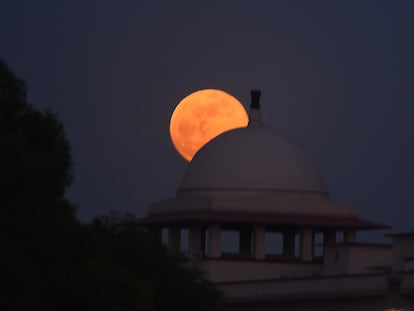Helium-3: Mining the fuel of the future on the Moon
Plans are already underway to harvest this material from the lunar surface where lunar water will also be available from its craters

Why go back to the Moon? The question was posed more than half a century ago and is once again being asked as the Americans and the Chinese prepare to return to the Earth’s only natural satellite. The two superpowers are doing it this time with the intention of staying for longer periods than the brief visits made by astronauts in the 1960s and 1970s, and the geopolitical interest in this race is indisputable.
But there are other reasons too. There is, of course, the yearning, implicit in human nature, to push the limits of human potential. When asked why he planned to conquer Everest, climber George Mallory famously replied, “Because it’s there.” Perhaps this could also explain the first Apollo flights, but today that sense of adventure has been overshadowed by more prosaic motivations.
That the Moon is an excellent scientific laboratory may be one aspect driving the new explorers. There are still many questions to be answered about the Moon’s origin, its evolution and the evolution of the solar system’s first epochs. The absence of atmosphere and magnetic field provides very special conditions for astronomical observations on its surface. And the hidden face would be a perfect place to install radio telescopes, safe from electromagnetic disturbances generated on Earth. Though, of course, simple scientific curiosity may not justify the enormous cost of the undertaking.
That’s where commercial interest comes in. Is there anything of value on the Moon that makes it commercially interesting? One obvious answer is water. Of course, on most of the Moon the existence of water, whether solid or liquid, is impossible: in a vacuum and in the heat of the day, any slab of ice would sublimate, and the gases would escape into space.
Ice in the dark craters
But in the polar regions the situation is different. Unlike the Earth, the Moon’s orbit and axis are very slightly inclined with respect to the ecliptic. There are almost no seasons there. At the poles, the sun’s rays are always angled at a sharp tangent and fail to reach the bottom of some of its deepest craters. Submerged in eternal darkness, temperatures are never more than -150ºC, allowing for the indefinite preservation of ice.
Several experiments have confirmed the existence of water ice, with some satellites detecting it by analyzing neutrons originating from cosmic ray bombardment, a symptom that points to the presence of a significant amount of hydrogen that would indicate the existence of water — not necessarily as water, but also as constituents of hydrated minerals. Others have employed the bistatic radar technique, which sends a radio signal to bounce off the bottom of these craters to then be picked up by large tracking antennas on Earth. Any distortion in the waves would be more typical of icy surfaces than of rocky terrain.
It is estimated that in the southern region of the Moon, there are about 10,000 square kilometers of permanent shadow zones. In these areas, the ice does not come in large sheets, but is instead mixed with the regolith in a kind of icy mud, meaning that from each cubic meter of terrain all that could be extracted in the best-case scenario would be the equivalent to a can of soda.
If lunar water is ever obtained, it will not be for human consumption or even sent to Earth. Purified, it would still most likely have an unpleasant taste, and we already have plenty of water on our planet. Its real use will be as a raw material to be broken down into oxygen and hydrogen — one of the most powerful combinations used to fuel rocket engines. This is exactly what Blue Origin’s future lunar landing spacecraft will consume, while SpaceX’s more conservative project will burn methane and oxygen.
The production of lunar water in industrial quantities will require large-scale facilities, difficult to imagine today when the mere construction of a modest permanent base on the Moon poses so many problems. But if someday the Moon becomes a kind of space gas station, those dark craters may be the most valuable terrain in our solar system.
Helium-3: the fuel of the future
But the Moon also has another element with enormous economic potential, Helium-3. This stable isotope is driven by the solar wind. On Earth, the magnetic field and the atmosphere act as a shield, but the Moon does not have such protection and, over the course of millions of years, Helium-3 has been bombarding the Moon in large quantities to become embedded in the lunar surface. At least in theory, the entire Moon is a deposit.
How much Helium-3 does the Moon conceal? Some estimates suggest between one and three million tons, almost all of it accumulated in the outer layers of the regolith, so its extraction would be relatively easy.
On Earth, trace amounts of Helium-3 remain trapped in layers of deep soil, occasionally escaping in emissions from certain gas fields. Most of it is produced artificially in nuclear reactors, by irradiating lithium or as a result of the decay of tritium, an element used in thermonuclear bombs. But the progressive dismantling of these arsenals has reduced its availability.
Helium-3 has been described as the fuel of the future in fusion power plants. Its reaction with deuterium releases enormous amounts of energy, giving off harmless Helium-4 atoms without the emission of dangerous radiation, making its capture and retention the holy grail of clean energy.
A scarce element
Currently, Helium-3 is only available in very small quantities, barely enough for some experiments. This, of course, makes it costly at more than $30,000 per gram. World consumption, conditioned by limited supply, is just over half a kilogram per year. It is used to build equipment for the nuclear industry, especially neutron detectors. It is also used to produce very low temperatures, of the order of a few tenths of a degree above absolute zero (-273.15ºC), a must in quantum instrumentation. And it is increasingly used in biomedical imaging applications such as magnetic resonance imaging and X-ray spectroscopy equipment.
Analysts estimate that there is a potential demand for Helium-3 worth about $400 million, indicating a clear upward tick. Helium-3 may be scarce on our planet, but there are easily exploitable deposits on the Moon since it is absorbed in the upper layers of the regolith. What might have seemed like science fiction 10 years ago is now a viable commercial proposition.
Several companies are now seriously considering trying to harvest Helium-3 from the lunar surface. The Seattle company Interlune has already raised venture capital of more than $13 million. Among its founders is 88-year-old astronaut Harrison Schmitt, the only geologist to have set foot on the Moon, giving him first-hand knowledge of the subject.
Interlune managers believe that Helium-3 is the only lunar product whose price justifies its extraction and transport to Earth. Consequently, they are designing an automatic robot to send to the Moon in 2025 as a prototype. In essence, it is a small excavator with an oven to heat the rock samples up to 600 degrees — enough, they hope, to cause the release of the occluded gas, which will be collected in small vials.
Powered by photoelectric cells, the robot will operate over a period of a couple of years during the two weeks of the lunar day while hibernating during the lunar night. The technique, which is, of course, an industrial secret, is only intended to obtain small samples. If successful, commercial exploitation will require larger vehicles, carried by SpaceX’s Starship freighters.
In any case, sending the gas vials to Earth will require return capsules with little cargo capacity, perhaps limited to a few kilos — enough to cover costs and leave a handsome profit. These do not, however, yet exist.
But say all conditions are satisfied, where will the digging start? According to Schmitt, the entire Moon offers possibilities, although some regions are more attractive than others. His study of lunar samples and data collected by orbiting satellites has helped him select the most promising regions identified with an X, as on a treasure map, though, of course, the map itself is another of the new space miners’ jealously guarded secrets.
Sign up for our weekly newsletter to get more English-language news coverage from EL PAÍS USA Edition










































